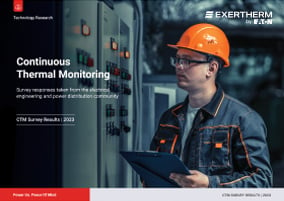Webinar
Industry Standards and Best Practices for Continuous Thermal Monitoring

John Hope
Chief Technology Officer

Tulsi Patel
Technical Operations and Support Manager
Americas Timing
12pm Central Daylight Time
Americas Timing
12pm Central Daylight Time
04 December 2024
Maximize Resilience in Mission Critical Assets: How Predictive Maintenance is Becoming a Standard Approach
Explore how Continuous Thermal Monitoring (CTM) enhances critical electrical equipment reliability.
What is Continuous Thermal Monitoring (CTM)?
Continuous Thermal Monitoring, or CTM, is a leading-edge solution that provides alternatives to infrared (IR) thermography surveys.
CTM is the next technology step from periodic maintenance that is important for implementing condition-based maintenance practices. It is a solution that enables data capture for analysis, allowing trends to inform predictive maintenance, enhance personnel safety and extend critical electrical equipment reliability.
CTM supplements or complements traditional periodic IR imagining surveys and other maintenance practices, enabling electrical maintenance teams to predict failures, safeguard electrical equipment, and optimize performance.

2025 CTM Survey is now live!
Driving the evolution from periodic maintenance to
predictive maintenance. Your insights matter.
It takes less than 2 minutes.
Let’s power the change together.
Benefits of Continuous Thermal Monitoring
Reduce the likelihood of electrical failures and improve operational stability with 24x7 monitoring.
Minimize human interaction with potentially faulty assets to increase personnel and on-site safety.
Reduce electrical fire or explosion risk resulting from arc flash due to compromised electrical assets.
Lower the need for additional costs and the unnecessary intrusion of unplanned maintenance.
Help Protect Critical Electrical Assets
Build a more sustainable and resilient electrical infrastructure by identifying the symptoms of electrical power failures.
Increase productivity
Increase asset production output by up to a quarter
Enhance efficiency
Substantial reductions to maintenance costs
Reduce outages
Greatly reduce the risk of equipment downtime
CTM Resources

CTM Survey Results 2024
Learn More
Learn how to Future Proof Electrical Assets
Electrical Hotspot Detection
CTM technology monitors temperature changes in critical electrical joints to identify potential failure points
Identify overheating joints to predict potential failures
Take preventative action early to avoid a power outage
Access asset data to analyze trends and discover insights
Build more sustainable and resilient power distribution systems
Thermography vs Monitoring
Discover the difference between periodic thermographic inspection and continuous thermal monitoring - click the buttons below
A current electrical inspection typically uses periodic thermographic scans to check temperature.
Reactive Maintenance
The ‘fix it when it breaks’ approach
Repair or replace equipment after a breakdown. Can lead to sudden and unpredictable production loss. A time and cost intense option with the lowest level of safety and system resiliency.
Periodic Maintenance
Scheduled inspection approach
Reactively inspect and repair equipment on a scheduled, periodic basis to prevent breakdowns, extend equipment lifespan, and reduce unplanned downtime.
Proactive Maintenance
Eliminate defects as early as possible
Assess risk with a condition snap-shot to identify and correct potential problems before they cause asset failure and loss of service.
Predictive Maintenance: Continuous Thermal Monitoring is the Always-On Sensor Solution
Continuous Monitoring
Always-on sensor technology provides real-time alerts
Identify Faults Early
Spot the signs of an outage before a failure occurs
Data-Driven Solution
Access electrical asset data for analysis and trends
- Thermography
- Monitoring
The Continuous Thermal Monitoring Solution
A rise in temperature is the main symptom of a faulty joint or connection that can result in major power failure in your mission critical environment. Exertherm Thermal Monitoring enables fault detection and predictive analysis of electrical temperature data 24x7. We provide a complete solution for LV switchgear/MV switchgear, Bus Duct, MCC, Dry Transformers, increasing efficiency and performance of your electrical infrastructure as an integral part of your predictive maintenance plan and IIoT strategy.

Frequently asked questions
From the basics to the more advanced, here’s a few questions we get asked a lot. If your question isn’t answered here please contact our sales team.
Why are Exertherm sensors hardwired, not wireless?
-1.png?width=24&height=24&name=Vector%20(2)-1.png)
- The most important issue is that wireless sensors create a potential threat to critical infrastructure operations because such systems are hackable. Exertherm sensors avoid any cyber security risks.
- Sensors described as wireless often have a very limited transmission distance – sometimes as low as 30 cm (SAW technology).
- Wireless sensors require antenna to pick up the wireless signal –usually several antennas will be required per vertical column
- The antenna are hard wired !- so perceived savings are actually not available.
- Wireless sensors operate on a limited number of frequencies – which can result in confusion if antenna pick up two sensors on same frequency – causes commissioning problems
- The wireless systems can only normally be commissioned on-site
- Wireless sensors require power to transmit the signal – that creates problems such as battery replacement costs / insufficient power to generate energy harvesting on LV equipment / requirement for re-calibration etc etc.
- Exertherm sensors avoid ALL these issues + Exertherm sensors come with a Lifetime Warranty/ zero maintenance guarantee – something wireless sensors cannot guarantee.
What integration options are available?
-1.png?width=24&height=24&name=Vector%20(2)-1.png)
- Raw data can be exported from Exertherm Datacards in Modbus 485 protocol
- Raw data can be exported in Modbus TCP/IP via use of a converter or via the Exertherm ARM XL HMI module
- Local and remote dry contact relays can be utilised via the Exertherm ARM XL module
- The MCC monitoring solution enables remote alarm via dry contact relay / export of raw data via Modbus 485, or export of raw data in Modbus TCP/IP via the Exertherm ARM XL HMI
- The MCC monitoring solution also provides a drawer/ bucket face mounted status LED to indicate Green = OK; Yellow = Warning level alarm; Red = Critical level alarm
Where would Exertherm Thermal Monitoring sensors be installed?
-1.png?width=24&height=24&name=Vector%20(2)-1.png)
LV and MV switchboards –key monitoring points using Exertherm non-contact passive infrared sensors.
- bus joints of line and load side of main incomer air circuit breakers
- line and load side of bus couplers / tie breakers
- Load side of ACB feeders
- optional shipping split bus joints
LV cable terminations;
- Line side main incomer ACB
- Load side feeder ACB
LV MCC : Using the Exertherm MCC kit which provides monitoring of incoming + outgoing power terminations fits INSIDE the drawer/ bucket.
Dry Resin Core Transformers using Exertherm non contact passive infrared sensors:
- Tap change connections
- HV both ends of coil terminations
- LV side bus joints
LV Power transformers :
- Input / output cable terminations
- Tap change connections
What is the ROI of installing Exertherm Thermal Monitoring sensors?
-1.png?width=24&height=24&name=Vector%20(2)-1.png)
Independent research indicates that there will be generic savings of circa 12% on current Opex maintenance costs. In addition, 24×7 condition monitoring will detect approx. 70% more failures in advance of the failure than periodic inspections. This will save on repair and replacement of equipment + associated downtime costs. The combined effect will produce circa 30% overall savings when compared to periodic inspection maintenance regime.
Calculations for typical 10 x switchboards with 5 columns per board indicate total savings of circa $250,000 over lifetime (20yr) of equipment.
There is also the Opportunity cost of not utilising condition monitoring. These include lost opportunity to increase safety by removing people from a place of potential risk to perform inspections.
Perhaps the greatest lost opportunity of not utilising condition monitoring will be the loss of the ability to collect 24x7 data of uniform quality for subsequent analysis to obtain the benefits of IIOT. Every piece of electrical equipment e.g. LV/MV switchboards, MCC, transformers etc which is built without the inclusion of sensors is building in obsolescence.
Why should I change from periodic thermal inspection to Continuous Thermal Monitoring (CTM)?
-1.png?width=24&height=24&name=Vector%20(2)-1.png)
There are a number of reasons which can be summarised as:
- Thermal inspections on electrical equipment are normally undertaken annually – that is one day out of 365 – less than 1% – which means a high dependence on luck to detect a failure condition in advance of the failure.
- Thermal inspections are not integrated into SCADA / BMS computerised systems and so cannot provide alarm notifications, trending, analysis etc.
- The thermal inspection temperature measurements are highly dependent on the quality of thermal camera and operator, thus data produced is not of a uniform quality. Further, thermal window infrared transmission deteriorates over time, making accurate indications of Go / No Go situations unreliable.
- Exertherm sensor technology provides proven accurate and reliable data of a uniform quality
- The IIOT “revolution” will globally transform the way electrical infrastructure is procured, operated, and maintained across all major industries. Installing sensors to create the data for subsequent analysis is a key part of the IIOT jigsaw since No Sensor = No data!
- ALL major OEMs now advocate the use of thermal condition monitoring over periodic inspection.
Why Choose Exertherm?
Discover the benefits of Continuous Thermal Monitoring (CTM) to improve safety, avoid outages, save costs, and access data.
24x7 Thermal Monitoring
Simple Installation
OEM Approved
Zero Maintenance
NFPA 70B Compliant
How Exerthem’s thermal sensors meet NFPA 70B compliance
- Monitor mission critical temperature changes 24x7
- Early warning of anomalies helps prevent system failures
- Improve safety by reducing human interaction with assets



.webp?width=2000&name=2024%20CTM%20Survey%20Results%20Website%20webp%20(1).webp)



